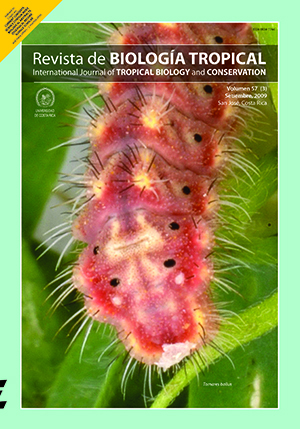Abstract
Few studies have evaluated seed predation in fragmented landscapes, in which lower species diversity is expected to modifying ecological interactions. The rates of seed removal by mammals were investigated in a continuous forest and two fragmented patches of Premontane Tropical Moist Forest, in Monteverde, Costa Rica. The composition of mammalian seed-predators in each site was recorded during 16 months. The removal of four native tree species of experimental seeds: Ocotea valeriana and Ocotea whitei (Lauraceae), Panopsis costaricensis (Proteaceae) and Billia colombiana (Hippocastanaceae) in forest understories was followed during two annual fruiting seasons for each species. Results indicated similar species composition of seed-predators between continuous forest, the largest fragment (350 ha). However the smaller fragment (20 ha), had fewer seed predators. In this fragment, the specialized seed predator Heteromys desmarestianus (Rodentia) was more abundant. Unexpectedly, seed-predation in the two forest fragments and the continuous forest did not differ statistically for any of the seed species. Apparently, the higher abundance of small seed-predators in the fragments was compensated by the absence of medium and large seed-predators, like Agouti paca, Dasyprocta punctata (both Rodentia) and Pecari tajacu (Artiodactyla) recorded in continuous forest. Removal of experimentally-placed seeds was higher when the number of naturally occurring seeds in the sites was lower. This result could best be attributed to differential satiation of seed predators rather than differences in richness or abundance of seed predators.##plugins.facebook.comentarios##

This work is licensed under a Creative Commons Attribution 4.0 International License.
Copyright (c) 2009 Revista de Biología Tropical
Downloads
Download data is not yet available.






